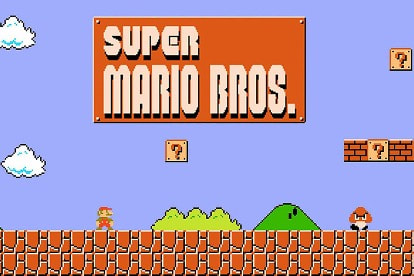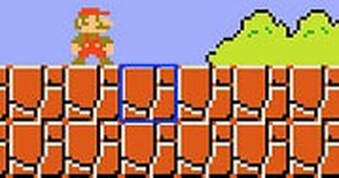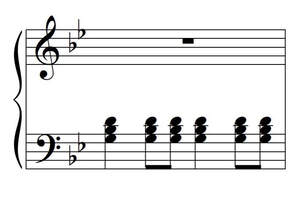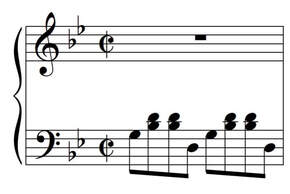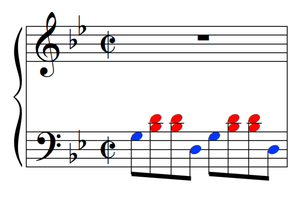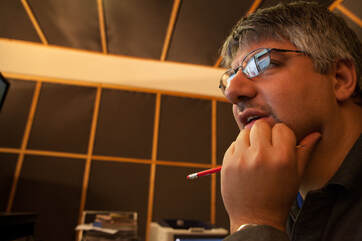Super Mario Bros and the use of Motifs in Music
by Nikolas Sideris
Super Mario Bros on really old computers
Back in 1985 computers didn't have the computing power, or the memory that current machines do. So they had to rely on using the same materials again and again. In this case and in many other games, even recent ones, the whole scene is built by using "tiles". A tile is a small graphic file, that takes up almost no memory, that can be reused, in succession, to create a solid fill.
Musical "tiles"?
|
Now what would you say if I was to tell you that music works in a similar way?
Below is the main melody, as played by the 1st violins, of Mozart's Symphony No. 40, K. 550. The time signature is 2/2 and it's fairly fast, and quite jolly. The fingering numbers and various signs are violin performance markings. Click on the YouTube link and listen to all 26 glorious minutes of music... |
|
Now the "tiles", previously mentioned, are more rhythmic in nature and as such can be transformed in various ways. Here is the same melody with the previously used blue rectangles to indicate the use of the "tiles". Oh... and from now on I'd like to refer to them as "patterns" or "motifs" - thank you!
A sloppy attempt at graphic design, I'll admit, but it is clear. Wolfgang used the same pattern 9 times over the course of 7 bars. For the record, in the first 16 bars, this pattern is actually used at least 19 times.
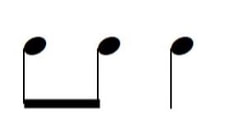
Here's the main pattern!
"But this is just a rhythm", I hear you say.
"Yes, but have a look at what you can do with it", I would immediately reply!
You can go up, go down, stay at the same note. And that's if you restrict yourself to using stepwise movement, rather than leaps in your melody. You can go move around further and allow yourself the freedom to go in different directions.
All of these potential uses of the pattern work, as you can see in the examples below.
By the way, if you play them on your piano, you might find that the third melody seems familiar. That's because it is the "William Tell overture" composed by Rossini. Rossini and Mozart used the same rhythmic motif!
By the way, if you play them on your piano, you might find that the third melody seems familiar. That's because it is the "William Tell overture" composed by Rossini. Rossini and Mozart used the same rhythmic motif!

Example 1

Example 2

Example 3
The placement of the pattern plays a vital role in the expression of the music, but that's not to say that it cannot be moved in a different place within the bar. This doesn't occur in any of the examples above, but it is possible, of course.
Additionally, if we suppose that the pattern consists of 3 notes (2 quavers and a crotchet), then taking the "head" of the pattern (the 2 quavers) and using it successively, also seems to yield good results (Example 1, bar 3).
Additionally, if we suppose that the pattern consists of 3 notes (2 quavers and a crotchet), then taking the "head" of the pattern (the 2 quavers) and using it successively, also seems to yield good results (Example 1, bar 3).
Music is more than just a melody
“Yes, but we're composing music for piano.”
You're right, you are, and as such you need to work on your harmony as well. Or your chords, or your left hand, or however you'd like to utilize your whole body (remember that last part).
So, at this point, I will have to assume that you know what harmony is and what a chord is. Forming them is not part of this text, but placing them in time is. If you wanted to use the same motif as it exists in the first full bar of Mozart's score in your left hand, you'd end up with something that looks like the following picture, which looks interesting, but perhaps not that inviting to pianists!
You're right, you are, and as such you need to work on your harmony as well. Or your chords, or your left hand, or however you'd like to utilize your whole body (remember that last part).
So, at this point, I will have to assume that you know what harmony is and what a chord is. Forming them is not part of this text, but placing them in time is. If you wanted to use the same motif as it exists in the first full bar of Mozart's score in your left hand, you'd end up with something that looks like the following picture, which looks interesting, but perhaps not that inviting to pianists!
I feel that the use of the rhythmic motif in this lonely bar is visible. But what about the following example?
Here the rhythmic motif is lost, among the quavers. Or is it? Have a look again, this time highlighted with different colours.
I agree that this is not the whole motif, but the quavers part is there. If we replace the lower D with a quaver rest, then our main pattern appears again (2 quavers and a crotchet). It is, however, misplaced by a quaver in the bar. That's no problem though, since it works very well with the original motif, complimenting each other.
Tell me the truth...
I will be honest with you. I've not seen anyone compose in such a way. It appears that this happens naturally for composers and artists in general. The mind loves seeing (or hearing) repeated patterns and the creative part of the mind is no exception to that. But this is a technique that can be used after you've came up with a melody, or you could go about creating a melody based on this and see where it takes you. It can be a good place to start and even if you have writers block, you can still get something out of this.
So, why am I telling you all of this?
First of all I wanted to give an insight to some basic analysis of a musical oeuvre. Secondly I wanted to showcase the almost endless possibilities that you can get by using 3 single notes. But more importantly I wanted you to have fun and learn at the same time. I hope I've succeeded!
Now there's only one thing missing - to tell you if I've ever played the original Super Mario Bros. The answer is no! But I've played lots of games, I've designed a few, and I've composed music for a few. It's all good fun, I promise you!
So, why am I telling you all of this?
First of all I wanted to give an insight to some basic analysis of a musical oeuvre. Secondly I wanted to showcase the almost endless possibilities that you can get by using 3 single notes. But more importantly I wanted you to have fun and learn at the same time. I hope I've succeeded!
Now there's only one thing missing - to tell you if I've ever played the original Super Mario Bros. The answer is no! But I've played lots of games, I've designed a few, and I've composed music for a few. It's all good fun, I promise you!

